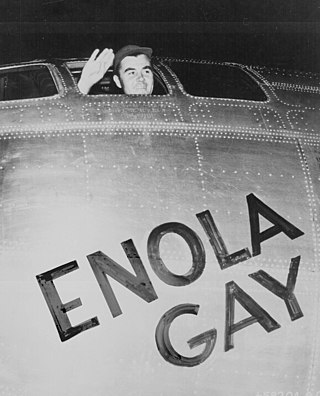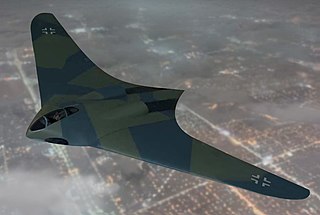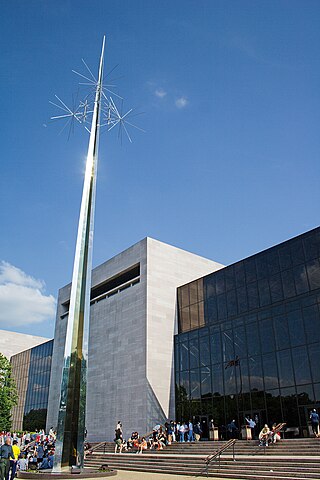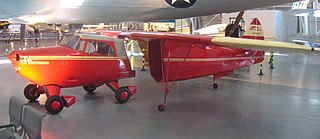
The Enola Gay is a Boeing B-29 Superfortress bomber, named after Enola Gay Tibbets, the mother of the pilot, Colonel Paul Tibbets. On 6 August 1945, during the final stages of World War II, it became the first aircraft to drop an atomic bomb in warfare. The bomb, code-named "Little Boy", was targeted at the city of Hiroshima, Japan, and caused the destruction of about three quarters of the city. Enola Gay participated in the second nuclear attack as the weather reconnaissance aircraft for the primary target of Kokura. Clouds and drifting smoke resulted in Nagasaki, a secondary target, being bombed instead.

Space Shuttle Discovery is a retired American spacecraft. The spaceplane was one of the orbiters from NASA's Space Shuttle program and the third of five fully operational orbiters to be built. Its first mission, STS-41-D, flew from August 30 to September 5, 1984. Over 27 years of service it launched and landed 39 times, aggregating more spaceflights than any other spacecraft to date. The Space Shuttle launch vehicle had three main components: the Space Shuttle orbiter, a single-use central fuel tank, and two reusable solid rocket boosters. Nearly 25,000 heat-resistant tiles cover the orbiter to protect it from high temperatures on re-entry.

The Horten H.IX, RLM designation Ho 229 was a German prototype fighter/bomber designed by Reimar and Walter Horten to be built by Gothaer Waggonfabrik. Developed at a late stage of the Second World War, it was one of the first flying wing aircraft to be powered by jet engines.

The National Air and Space Museum (NASM) of the Smithsonian Institution, is a museum in Washington, D.C., in the United States dedicated to human flight and space exploration.

The Kyūshū J7W Shinden is a World War II Japanese propeller-driven prototype fighter plane with wings at the rear of the fuselage, a nose-mounted canard, and a pusher engine.
Steven Ferencz Udvar–Házy, also known as István or Steve Hazy, is a Hungarian-American billionaire businessman and the executive chairman of Air Lease Corporation. He is the former chairman and CEO of International Lease Finance Corporation (ILFC), one of the two largest aircraft lessors in the world. Forbes magazine's 2021 list of The World's Billionaires estimated his net worth at US$4 billion.

The Steven F. Udvar-Hazy Center, also called the Udvar-Hazy Center, is the Smithsonian National Air and Space Museum (NASM)'s annex at Washington Dulles International Airport in the Chantilly area of Fairfax County, Virginia. It holds numerous exhibits, including the Space Shuttle Discovery, the Enola Gay, and the Boeing 367-80, the main prototype for the popular Boeing 707 airliner.

The Fulton FA-2 Airphibian was an American roadable aircraft manufactured in 1946.

The Boeing 367-80 is a retired American four-engined jet prototype aircraft built by Boeing to demonstrate the advantages of jet propulsion for commercial aviation. It served as basis for the design of the KC-135 tanker and the 707 airliner.
Operation LUSTY was the United States Army Air Forces' effort to capture and evaluate German aeronautical technology during and after World War II.

Flak-Bait is a Martin B-26 Marauder aircraft that holds the record within the United States Army Air Forces for the number of bombing missions survived during World War II. Manufactured in Baltimore, Maryland, as a B-26B-25-MA, by Martin, it was completed in April 1943, accepted by the United States Army Air Forces, and christened Flak-Bait by its first assigned pilot, James J. Farrell, who adapted the nickname of a family dog, "Flea Bait". Flak-Bait was assigned to the 449th Bombardment Squadron, 322d Bombardment Group stationed in eastern England.

The Swoose is a B-17D-BO Flying Fortress, USAAF serial number 40-3097, that saw extensive use in the Southwest Pacific theatre of World War II and survived to become the oldest B-17 still intact. It is the only early "shark fin"-tailed B-17 known to exist, and the only surviving B-17 to have seen action in the 1941–42 Philippines Campaign, operating on the first day of the United States entry into the war.

Shoo Shoo Shoo Baby, originally Shoo Shoo Baby, is a Boeing B-17 Flying Fortress in World War II, preserved and currently in storage at the National Museum of the United States Air Force, awaiting transfer to the Smithsonian's National Air and Space Museum. A B-17G-35-BO, serial number 42-32076, and manufactured by Boeing, it was named by her crew for a song of the same name made popular by The Andrews Sisters, the favorite song of its crew chief T/Sgt. Hank Cordes. Photographs of the bomber indicate that a third "Shoo" was added to the name at some point in May 1944 when the original aircraft commander completed his tour of duty and was replaced by another pilot.

Paul Edward Garber was the first head of the National Air Museum of the Smithsonian Institution, in Washington, D.C. Through his work and effort, the most complete collection of historical aircraft in the world was gathered and preserved. It contains the sole survivors of many interesting historical aircraft types.

The Monnett Moni is a sport aircraft developed in the United States in the early 1980s and marketed for homebuilding.

The McDonnell TD2D Katydid was a pulsejet-powered American target drone produced by McDonnell Aircraft that entered service with the United States Navy in 1942, and continued in use until the late 1940s.

The Westinghouse J32 was a small turbojet engine developed by the Westinghouse Aviation Gas Turbine Division in the mid-1940s.
Conservation and restoration at the Smithsonian Institution deals with the care of the 138 million artifacts located in the collections of Smithsonian Institution. Work is conducted by one research center, the Museum Conservation Institute (MCI), and by conservators at the Smithsonian's museums, galleries, zoo. Smithsonian conservators provide myriad services to their units, including exhibit preparation of the museum collection and loan objects, advising on object care, training for future generations of conservationists, engaging in routine preventive care on a daily basis, conducting research projects related to the collections, and examining objects for evidence of manufacturing techniques and previous restorations All conservation labs collectively further the mission of the Smithsonian Institution, "the increase and diffusion of knowledge." Founded in 1846 the Smithsonian is the world's largest museum and research complex, consisting of 19 museums and galleries, the National Zoological Park, and nine research facilities.















